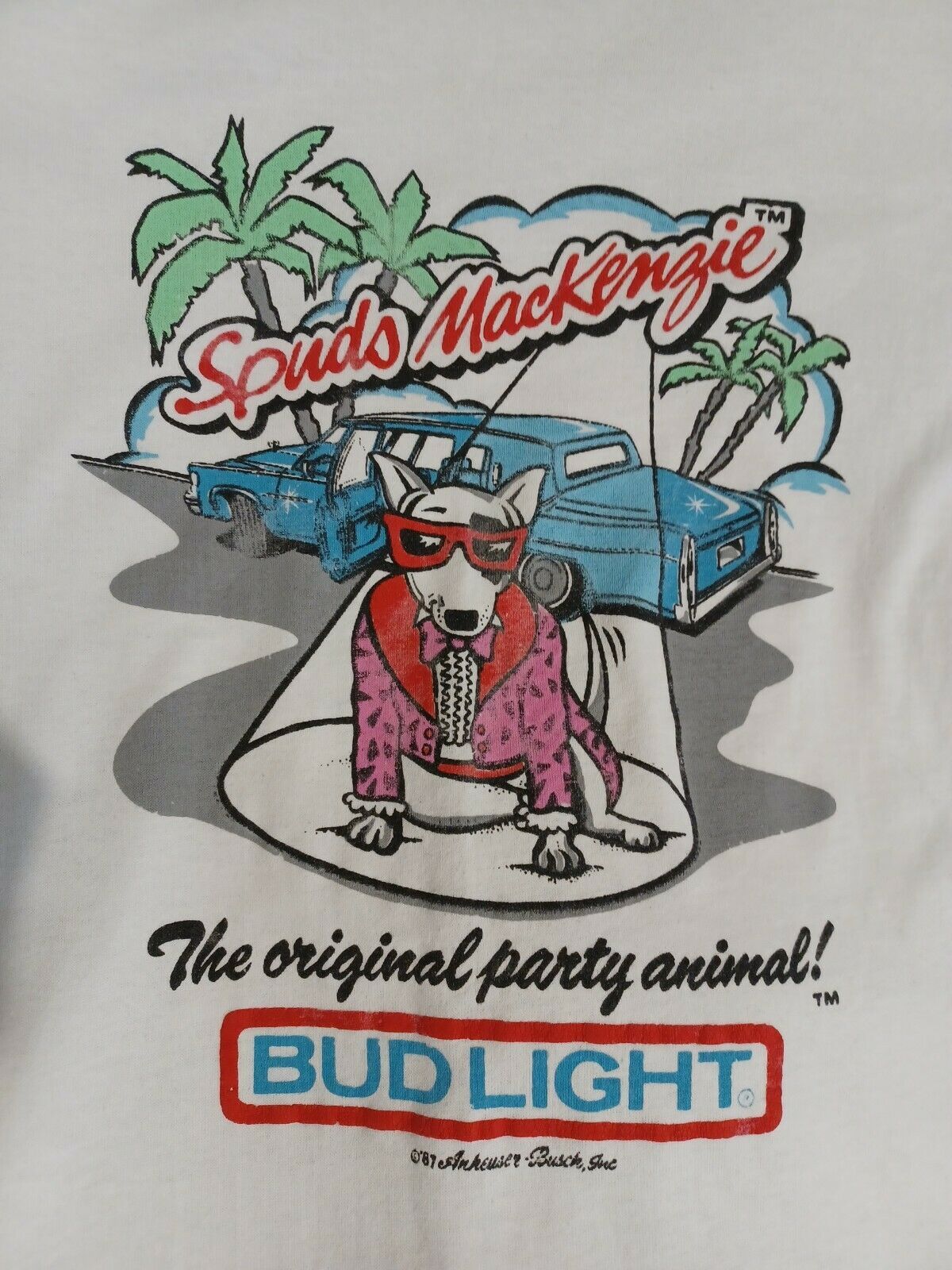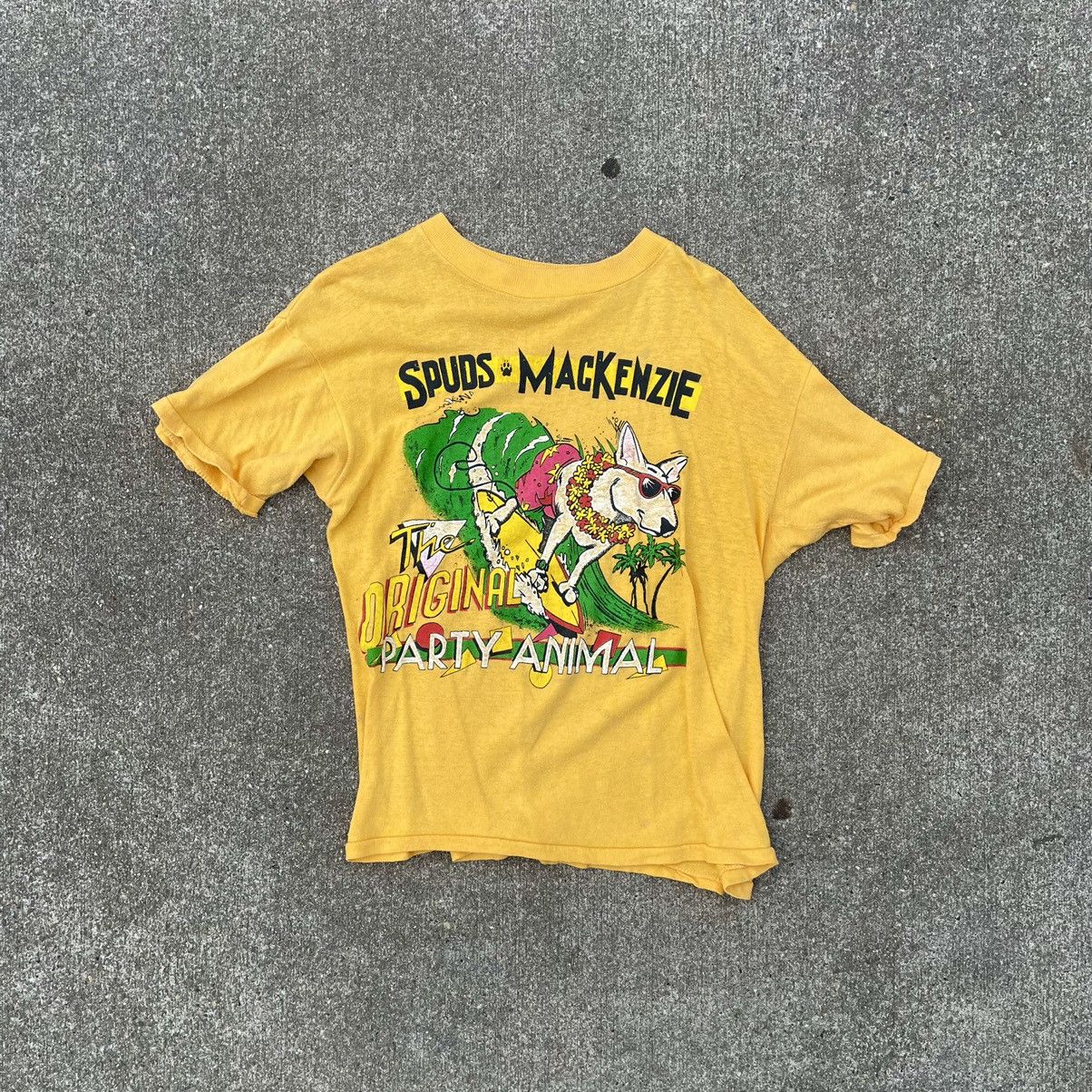Spuds Mackenzie: Unraveling The Mystery Of Bud Light's Party Animal
In the vibrant, often audacious landscape of late 1980s American pop culture, few advertising campaigns captured the national imagination quite like the one featuring Spuds Mackenzie. This fictional bull terrier dog character, an icon of cool and carefree living, became synonymous with Bud Light beer, transforming a simple beverage into a symbol of fun and festivity. For those too young to remember, Spuds Mackenzie wasn't just a mascot; he was a phenomenon, a marketing marvel that defied expectations and etched himself into the annals of advertising history.
From his debut on a promotional poster in 1983 to his legendary Super Bowl commercial appearance in 1987, Spuds Mackenzie captivated audiences with his charming personality, ever-present sunglasses, and undeniable party vibe. This article delves deep into the fascinating story of Spuds Mackenzie, exploring his origins, the controversies that surrounded him, his enduring legacy, and the unique characteristics of the Bull Terrier breed that brought him to life. Prepare to journey back to a time when a dog, a beer, and a clever marketing strategy created one of the most surprising and beloved American pop culture figures ever.
The Unforgettable Debut of Spuds Mackenzie: A Marketing Phenomenon
The story of Spuds Mackenzie is, at its heart, a testament to stellar marketing. While such a sentence might be reluctantly muttered in recent times concerning Bud Light, back in the late 1980s, it was an undeniable truth. The beloved bull terrier was first selected to represent the brand in 1983, making his quiet debut on a promotional poster, casually sporting a fraternity sweatshirt and posing with an air of effortless cool. This initial appearance laid the groundwork for what was to become an extensive advertising campaign.
However, it was in 1987 that Spuds truly exploded onto the national scene. Bud Light, seeking to capture the hearts of the American public, introduced their adorable bull terrier mascot in a Super Bowl commercial. The impact was immediate and profound. Spuds, quickly dubbed "the original party animal," became an instant sensation. His image, often seen with a spiked collar and a Bud Light in hand (though it was always implied, never actually consumed by the dog), resonated with a generation looking for fun and lightheartedness. This strategic move paid off handsomely for the brand; the fictional dog helped Bud Light's sales soar by an astonishing 20% in just one year. This was more than just an ad campaign; it was a cultural moment, demonstrating the immense power of a well-crafted mascot to drive brand recognition and sales. Spuds Mackenzie wasn't just selling beer; he was selling a lifestyle, a feeling of endless celebration and good times.
Beyond the Beer Can: Understanding the Bull Terrier Breed
While Spuds Mackenzie was a fictional character, the breed that brought him to life—the Bull Terrier—is very real and possesses a unique charm that has captured the hearts of many dog lovers worldwide. Understanding the characteristics of this breed helps to appreciate why a Bull Terrier was chosen for such a prominent role.
A Brief History of the Bull Terrier
The Bull Terrier breed originated in England in the early 19th century. They were initially bred by crossing Bulldogs with various terrier breeds, primarily for dog fighting. However, as dog fighting became illegal, breeders began to refine the breed, aiming for a more companionable and aesthetically pleasing dog. James Hinks is largely credited with developing the modern Bull Terrier, specifically creating the "White Cavalier" variant, known for its distinctive egg-shaped head and muscular build. Over time, their aggressive tendencies were bred out, leading to the playful and affectionate dogs we know today.
Unique Characteristics of the Bull Terrier
Bull Terriers are truly fascinating dogs with a distinctive appearance and personality. Their most recognizable feature is their unique egg-shaped head, often described as having a "roman nose," with small, triangular eyes. They are robust, muscular dogs, exuding an air of strength and agility. Beyond their striking looks, Bull Terriers are known for their:
- Temperament: Despite their historical background, modern Bull Terriers are typically known for being playful, energetic, and highly affectionate. They are often described as "clowns" due to their mischievous and entertaining antics. They bond strongly with their families and can be very loyal.
- Energy Levels: They are high-energy dogs that require significant physical activity and mental stimulation to stay happy and well-behaved. This energetic nature certainly played into Spuds Mackenzie's "party animal" persona.
- Intelligence: Bull Terriers are intelligent dogs, but they can also be stubborn, which means consistent and positive training is essential from a young age.
- Sociability: With proper socialization, Bull Terriers can get along well with children and other pets, though their strong prey drive means careful introductions are necessary, especially with smaller animals.
The choice of a Bull Terrier for the Spuds Mackenzie campaign was astute. Their unique, memorable appearance and inherently playful nature made them perfect for embodying a fun-loving, charismatic character that could appeal to a broad audience.
The Life and Times of Spuds Mackenzie: From Poster to Pop Culture Icon
The journey of Spuds Mackenzie from a mere concept to a full-blown cultural phenomenon is a compelling narrative in the history of advertising. As mentioned, his initial foray into the public eye was subtle, appearing on a promotional poster in 1983. This early image, showing him in a fraternity sweatshirt, hinted at the "party animal" persona that would soon define him.
However, it was his transition to television, particularly the iconic Super Bowl commercials of the late 1980s, that cemented his status as a TV star. Spuds was consistently portrayed as the ultimate party host, surrounded by beautiful women, engaging in various leisure activities like surfing, and always sporting his signature sunglasses. He was the epitome of cool, effortless fun, and his presence instantly elevated the perceived lifestyle associated with Bud Light. The character was so pervasive that his image extended far beyond commercials, appearing on a vast array of merchandise, from vinyl stickers and decals for cars and laptops to various collectibles available on platforms like eBay. He was a beloved and iconic figure, not just in the 1980s but well into the 1970s as well, as his initial conceptualization and rise to prominence began earlier in that decade.
The advertising agency Needham, Harper, and Steers in Chicago was instrumental in bringing Spuds to life. The creative minds there understood the power of an anthropomorphic mascot and crafted a persona that was both aspirational and relatable. Spuds Mackenzie, the original party animal, truly captured hearts with his charming personality, spiked collar, and the ever-present (though never consumed) Bud Light. He was, and remains, a vivid throwback to a specific era of American advertising and pop culture.
The Controversies That Shook the Party
Despite his immense popularity and commercial success, the Spuds Mackenzie campaign was not without its share of controversies. These issues, though perhaps minor in retrospect, highlighted the complexities of advertising, especially when targeting a broad audience with a character that appealed across age groups.
One of the most significant controversies revolved around the revelation that the dog playing Spuds Mackenzie was, in fact, a female Bull Terrier named Evie. The advertising campaign consistently presented Spuds as a male "party animal," leading to widespread public surprise and some amusement when the truth emerged. This detail, that she "fooled the world into thinking she was a man," became a notable footnote in the character's history. While perhaps not a major scandal, it certainly added a layer of intrigue and discussion around the campaign.
More seriously, Spuds Mackenzie faced criticism from various parent and consumer groups, notably Mothers Against Drunk Driving (MADD) and Senator Strom Thurmond. Their primary concern was that the adorable and charismatic dog mascot, with his widespread appeal, might inadvertently encourage underage drinking or normalize alcohol consumption for children. The argument was that a cute, anthropomorphic character, particularly one so prominently featured, could blur the lines for younger audiences, making beer seem appealing or harmless. This led to calls for the campaign to be pulled or modified. While Anheuser-Busch, Bud Light's parent company, maintained that Spuds was always intended for adult audiences and was part of a responsible marketing strategy, the controversy put a spotlight on the ethics of using animal mascots in alcohol advertising. These debates ultimately contributed to the campaign's eventual retirement, demonstrating the power of public and political pressure on advertising practices.
The Enduring Legacy and Surprising Resurrection
Even after his original advertising campaign concluded, the legacy of Spuds Mackenzie continued to resonate. He remained a potent symbol of 1980s pop culture, a nostalgic touchstone for those who remembered his heyday. His image persisted on various memorabilia, becoming a collector's item and a retro fashion statement. The phrase "Spuds Mackenzie" itself became shorthand for a carefree, party-loving attitude.
For years, Spuds existed primarily in the realm of fond memories and vintage merchandise. However, in a move that surprised and delighted many, Bud Light decided to bring back their iconic mascot. In 2017, Spuds Mackenzie was resurrected for a new series of commercials. This return was a clever nod to nostalgia, reintroducing the original party animal to a new generation while reminding older fans of his enduring charm. The resurrected Spuds, while still embodying the spirit of fun and celebration, had evolved. As the data suggests, he had "changed for the better," no longer drinking beer (aligning with more contemporary responsible drinking messages) but still surfing, wearing sunglasses, and partying hard. This revival demonstrated the lasting power of a truly iconic brand mascot and its ability to adapt to changing times while retaining its core appeal. It was a testament to the character's timeless appeal and his indelible mark on advertising history.
Spuds Mackenzie's Impact on Advertising and Brand Strategy
The story of Spuds Mackenzie is a case study in effective brand strategy and the power of a well-executed advertising campaign. His success, which saw Bud Light's sales soar by 20% in a single year, serves as a powerful example of how a compelling mascot can transcend mere product promotion to become a cultural icon.
At a time when advertising was becoming increasingly sophisticated, Spuds Mackenzie stood out for his simplicity and universal appeal. He didn't speak, he didn't offer complex narratives; he simply exuded an aura of fun and good times. This created an emotional connection with consumers, making Bud Light feel less like a product and more like an invitation to a party. This approach highlights several key principles of effective advertising:
- Emotional Resonance: Spuds tapped into a desire for escapism and lightheartedness, associating the beer with positive emotions and experiences.
- Memorability: His distinctive look and consistent persona made him instantly recognizable and unforgettable, cutting through the clutter of other advertisements.
- Brand Personification: By embodying the brand's desired image (fun, cool, social), Spuds gave Bud Light a personality that consumers could relate to and aspire to.
- Cultural Integration: The campaign wasn't just an ad; it became a part of the cultural fabric, sparking conversations, merchandise, and even controversy, all of which kept the brand in the public consciousness.
While modern marketing often focuses on digital engagement and data-driven insights, the Spuds Mackenzie phenomenon reminds us of the enduring power of creative storytelling and the human (or in this case, canine) element in building brand loyalty. He proved that sometimes, all it takes is an adorable bull terrier in sunglasses to win people's hearts and boost sales dramatically.
Adopting a Bull Terrier: What You Need to Know
Inspired by the charm of Spuds Mackenzie, many people might consider adopting a Bull Terrier. It's crucial to understand that while they are captivating dogs, they require specific care and a committed owner. Adopting any dog is a significant responsibility, and for a breed with the unique characteristics of a Bull Terrier, thorough preparation is key.
Responsible Ownership and Care
Bull Terriers are not for everyone. Their high energy levels, strong will, and need for consistent training mean they thrive best with experienced dog owners who can dedicate time and effort. Here are some key considerations for their care:
- Training and Socialization: Early and consistent training is paramount. Bull Terriers benefit greatly from positive reinforcement methods. Socialization from a young age is also crucial to ensure they are well-adjusted and comfortable around other people and animals.
- Exercise Needs: These dogs require a substantial amount of daily exercise. Regular walks, playtime in a secure yard, and engaging activities are essential to prevent boredom and destructive behaviors. They are not content being couch potatoes.
- Mental Stimulation: Beyond physical exercise, Bull Terriers need mental challenges. Puzzle toys, training sessions, and interactive games can keep their intelligent minds engaged.
- Health Considerations: Like all breeds, Bull Terriers are prone to certain health issues, including deafness (especially in white varieties), heart conditions, and kidney problems. Regular veterinary check-ups are vital.
- Grooming: Their short coats are relatively low maintenance, requiring only weekly brushing. However, regular nail trims and ear cleaning are necessary.
Finding the Right Bull Terrier for You
If you're determined to welcome a Bull Terrier into your home, it's important to find a reputable source. Avoid backyard breeders or pet stores, as these often contribute to irresponsible breeding practices. Instead, consider:
- Reputable Breeders: A good breeder will prioritize the health and temperament of their dogs, perform health screenings, and be transparent about their breeding practices. They will also be eager to educate potential owners and ensure their puppies go to suitable homes.
- Breed-Specific Rescues: Many Bull Terriers end up in shelters or rescue organizations through no fault of their own. Adopting from a rescue can be a rewarding experience, giving a deserving dog a second chance. Rescue organizations often have a thorough adoption process to match dogs with appropriate families.
Adopting a Bull Terrier means committing to a loyal, playful, and energetic companion who will bring immense joy and entertainment to your life, much like the original party animal, Spuds Mackenzie.
Frequently Asked Questions About Spuds Mackenzie
The enduring popularity of Spuds Mackenzie often leads to common questions from those who remember him and those discovering him for the first time. Here are some of the most frequently asked questions about this iconic character:
- Was Spuds Mackenzie a real dog?
Yes, the character of Spuds Mackenzie was portrayed by a real Bull Terrier dog, primarily one named Evie. While the persona was fictional, the canine actor was very real.
- Was Spuds Mackenzie male or female?
This was one of the most famous controversies! Spuds Mackenzie was consistently portrayed as a male "party animal" in the commercials, but the dog who most famously played him, Evie, was female. She "fooled the world into thinking she was a man."
- When did Spuds Mackenzie appear in commercials?
Spuds Mackenzie first debuted on a promotional poster in 1983. His most iconic appearances were in Bud Light Super Bowl commercials starting in 1987, running through the late 1980s.
- Why was Spuds Mackenzie controversial?
The primary controversy stemmed from concerns by parent groups and politicians (like Senator Strom Thurmond) that the cute and appealing dog mascot might inadvertently encourage underage drinking or normalize alcohol consumption for children, despite Bud Light's insistence that the campaign was aimed at adults.
- Did Spuds Mackenzie return to advertising?
Yes, after his original campaign ended, Spuds Mackenzie made a surprising return in 2017 for a new series of Bud Light commercials. In this revival, he no longer drank beer but still maintained his fun, party-loving persona.
- What kind of dog was Spuds Mackenzie?
Spuds Mackenzie was a Bull Terrier, a breed known for its distinctive egg-shaped head, muscular build, and playful, energetic temperament.
The story of Spuds Mackenzie is a fascinating chapter in advertising history, showcasing how a well-crafted character, even a fictional dog, can leave an indelible mark on popular culture and significantly impact a brand's fortunes. From his humble beginnings on a promotional poster to his status as a Super Bowl sensation and a figure of both adoration and controversy, Spuds Mackenzie remains an iconic symbol of the late 1980s. His legacy continues, reminding us of the power of creativity, charm, and a little bit of party animal spirit.
What are your fondest memories of Spuds Mackenzie? Did you have any Spuds merchandise? Share your thoughts and recollections in the comments below! If you enjoyed this dive into advertising history, be sure to explore other articles on our site about iconic brand mascots and their cultural impact.

spuds mackenzie on Tumblr

Spuds Mackenzie | Logo Design Contest | LogoTournament

Vintage Spuds Mackenzie 80’s | Grailed